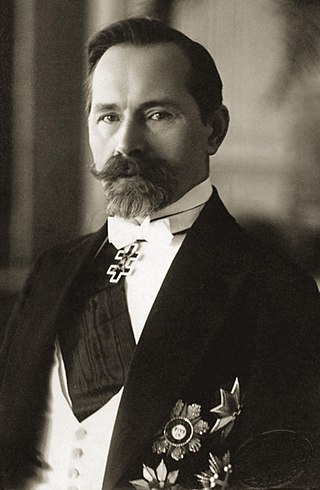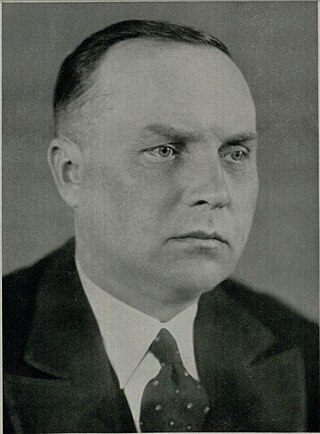
Antanas Smetona was a Lithuanian intellectual, journalist and politician who served as the first president of Lithuania from 1919 to 1920 and again from 1926 until the Soviet occupation of Lithuania in 1940. Referred to as the "Leader of the Nation" during his presidency, Smetona is recognised as one of the most important Lithuanian political figures between World War I and World War II, and a prominent ideologists of Lithuanian nationalism and the movement for national revival.

Mykolas Sleževičius was a Lithuanian lawyer, political and cultural figure, and journalist. One of the most influential figures in inter-war Lithuania, he served as the prime minister of Lithuania on three occasions. Taking the helm of the government at a difficult time in 1918 and again in 1919, Sleževičius has been credited with preparing Lithuania for the fights to come and for laying the foundations of the fledgling state.
The State Council of Lithuania was a legislative institution in interwar Lithuania. It was an advisory institution that codified existing and proposed new laws. It was established by the constitution adopted on 15 May 1928. President Antanas Smetona dismissed the Third Seimas in March 1927. Although the constitution of 1928 retained the Seimas as the legislative body, new elections were not called until June 1936. In the absence of a parliament, the State Council performed some legislative functions of the Lithuanian government. It was liquidated on 26 July 1940 by the People's Government of Lithuania. Its chairman in 1928–1938 was Stasys Šilingas who became the prime legal architect of the authoritarian regime of Smetona. The archives of the council were lost after the Soviet occupation. Therefore, its activities are known mainly from the press, memoirs of its members, and documents of other institutions.

Vladas Mironas was a Lithuanian Catholic priest and politician. He was one of the twenty signatories of the Act of Independence of Lithuania and served as the Prime Minister of Lithuania from March 1938 to March 1939.

Lietuvos aidas is a daily newspaper in Lithuania. It was established on September 6, 1917, by Antanas Smetona, and became the semi-official voice of the newly formed Lithuanian government. When the government evacuated from Vilnius to the temporary capital, Kaunas, it ceased publication. The newspaper was revived in 1928 as the newspaper of the Lithuanian government and became the most popular newspaper in Lithuania. At its peak, it published three daily editions with combined circulation of 90,000 copies. World War II disrupted its publication. In 1990, after Lithuania declared independence from the Soviet Union, the newspaper once again became the official newspaper of the Supreme Council of the Republic of Lithuania. At the end of 1992, its circulation reached 103,000 copies. However, it was soon privatized and faced shrinking readership, financial difficulties, and other controversies. In April 2006, bankruptcy proceedings were initiated by the State Tax Inspectorate when its tax debts reached more than 4 million litas. The company was liquidated in 2015, but the newspaper continues to be published by a non-profit organization.

The signatories of the Act of Independence of Lithuania were the twenty Lithuanian men who signed the Act of Independence of Lithuania on February 16, 1918. The signatories were elected to the Council of Lithuania by the Vilnius Conference in September 1917 and entrusted with the mission of establishing an independent Lithuanian state. The proclaimed independence was established only in late 1918, after Germany lost World War I and its troops retreated from Lithuanian territory. What followed was a long process of building the state, determining its borders, and gaining international diplomatic recognition. The signatories succeeded in their mission and independent Lithuania survived until the Soviet Union occupied the state on June 15, 1940.

The 1926 Lithuanian coup d'état was a military coup d'état in Lithuania that replaced the democratically elected government with a nationalist regime led by Antanas Smetona. The coup took place on 17 December 1926 and was largely organized by the military; Smetona's role remains the subject of debate. The coup brought the Lithuanian Nationalist Union, the most conservative party at the time, to power. Previously it had been a fairly new and insignificant nationalistic party. By 1926, its membership reached about 2,000 and it had won only three seats in the parliamentary elections. The Lithuanian Christian Democratic Party, the largest party in the Seimas at the time, collaborated with the military and provided constitutional legitimacy to the coup, but accepted no major posts in the new government and withdrew in May 1927. After the military handed power over to the civilian government, it ceased playing a direct role in political life.

The Third Seimas of Lithuania was the third parliament (Seimas) democratically elected in Lithuania after it declared independence on 16 February 1918. The elections took place on 8–10 May 1926. For the first time the Lithuanian Christian Democratic Party were forced to remain in opposition. The coalition government made some unpopular decisions and was sharply criticized. Regular Seimas work was interrupted by a military coup d'état in December 1926 when the democratically elected government was replaced with the authoritarian government of Antanas Smetona and Augustinas Voldemaras. The Third Seimas was dissolved on 12 March 1927 and new elections were not called until 1936.
The Fourth Seimas of Lithuania was the fourth parliament (Seimas) elected in Lithuania after it declared independence on 16 February 1918. The elections took place on 9 and 10 June 1936, a bit less than ten years after the Third Seimas was dissolved by President Antanas Smetona. The Seimas commenced its work on 1 September 1936. Its five-year term was cut short on 1 July 1940 when Lithuania lost its independence to the Soviet Union. It was replaced by the People's Seimas in order to legitimize the occupation. Konstantinas Šakenis was the chairman of the Seimas.
The Lithuanian Christian Democratic Party was a Christian-democratic political party in Lithuania.
The Farmers' Party was a liberal political party in inter-war Lithuania.

Varniai concentration camp was an internment camp in Varniai, Lithuania. It was created a month after the coup d'état of December 1926 to house political prisoners, mostly members of the outlawed Communist Party of Lithuania. In total, more than 1,000 people passed through the camp before it was closed in 1931 due to financial difficulties brought by the Great Depression. Later, the authoritarian regime of Antanas Smetona operated two other internment camps, one in Dimitravas in 1936 and another in Pabradė in 1939.
The Tauragė Revolt was an anti-government revolt that took place in Tauragė, Lithuania on 9 September 1927. Members of the Social Democratic Party of Lithuania and Lithuanian Popular Peasants' Union wanted to remove President Antanas Smetona from power. The rebels took control of Tauragė, the revolt spread to neighboring villages and their forces grew to 200 men. However, the revolt was poorly prepared and was suppressed the same day by units of the Lithuanian Army that arrived from Klaipėda. In the aftermath, over 300 people were arrested and 11 were executed. A group of rebels escaped abroad where they became known as plečkaitininkai and, with the help from Poland, continued to plot against Smetona's regime until the mid-1930s. It was one of 13 attempts to overthrow Smetona's regime in 1926–1938.

Sofija Smetonienė, was the wife of the first President of Lithuania Antanas Smetona and served as the First Lady of Lithuania from April 4, 1919, to June 19, 1920, and again from December 19, 1926, to June 15, 1940. Sofija was a member of the Chodakowski noble family.
The plečkaitininkai ("plečkaitists"), named after Jeronimas Plečkaitis, was a group of Lithuanian political opponents of the authoritarian regime of Antanas Smetona active abroad from 1927 to 1935. They were mainly social democrats who had escaped abroad in the aftermath of the unsuccessful Tauragė Revolt in September 1927. With support from Poland, they sought to organize a coup against the ruling Lithuanian Nationalist Union and engaged in limited terrorist activities. The group continued to maintain relations with the Social Democratic Party of Lithuania but distanced themselves from the Communist Party of Lithuania. Plečkaitininkai did not enjoy any significant support in Lithuania, but the Lithuanian government used the threat of this group as one of the arguments for suppressing free press and spying on leftist organizations.

The Lithuanian Nationalist Union, also known as the Nationalists, was the ruling political party in Lithuania during the authoritarian regime of President Antanas Smetona from 1926 to 1940. The party was established in 1924 but was not popular. It came to power as a result of the December 1926 military coup. From 1927 to 1939, the Council of Ministers included only members of the LTS. In 1936, other parties were officially disbanded, leaving LTS the only legal party in the country. At the end of the 1930s new members started bringing in new ideas, right wing and closer to Italian Fascism. The party was disestablished after the Soviet occupation of Lithuania in June 1940. A party of the same name was reestablished in 1990 and claims to be the successor of the interwar LTS.
The coup d'état attempt in 1934 was an attempt by voldemarininkai, supporters of the former Prime Minister Augustinas Voldemaras, to overthrow the government of President Antanas Smetona. While voldemarininkai planned several coups against the government, this coup was the largest and most threatening.
Karolis Didžiulis was a Lithuanian communist politician and statesman. He was a member of the Central Committee of the Communist Party of Lithuania in 1927–1958 and chairman of the Supreme Court of the Lithuanian SSR in 1947–1958.

Jonas Lapėnas was a Lithuanian businessman and activist of the Lithuanian Nationalist Union. He was director of the meat processing and export company Maistas and chairman of the cooperative union Lietūkis. He was chairman of the Nationalist Union in 1929–1931.










